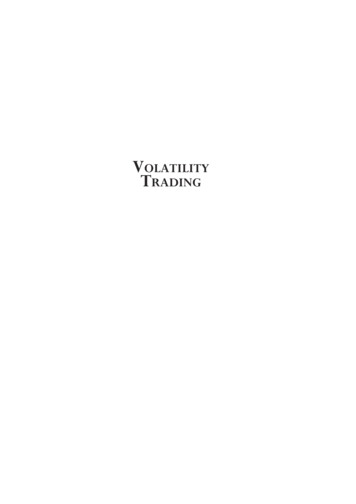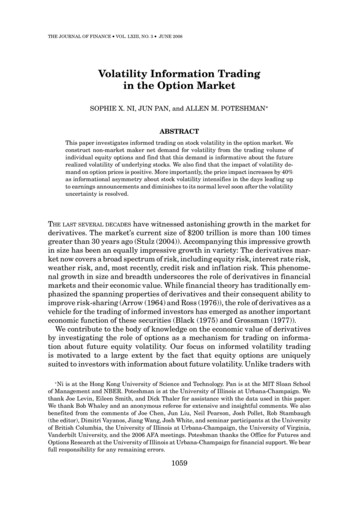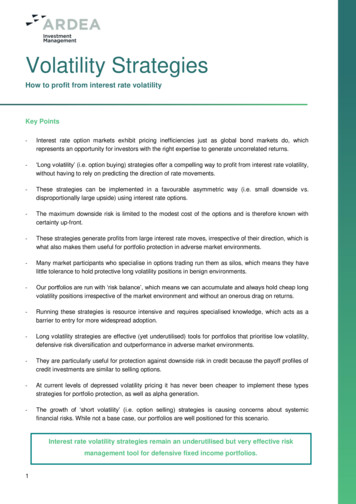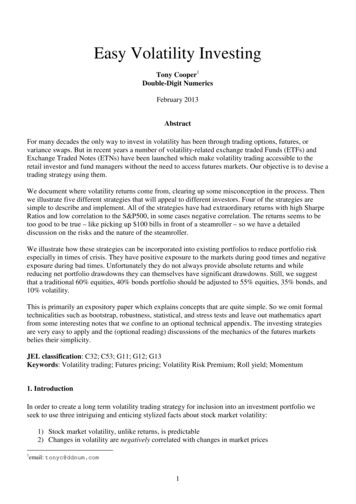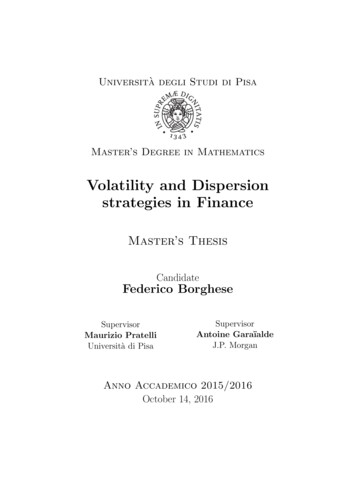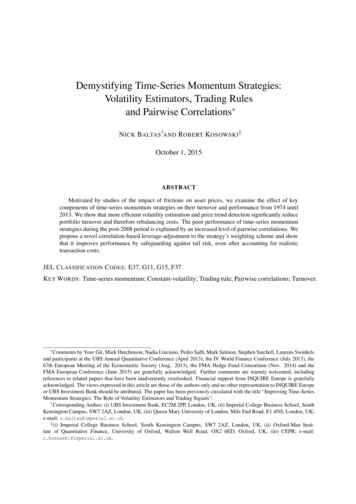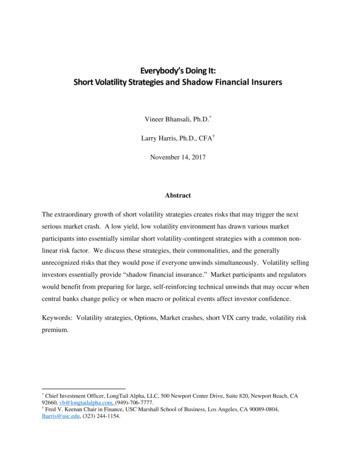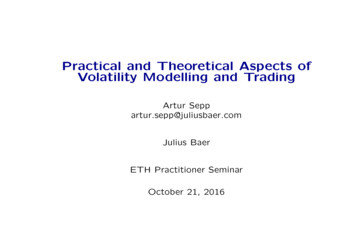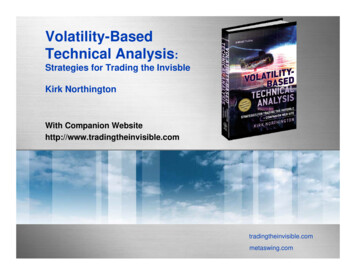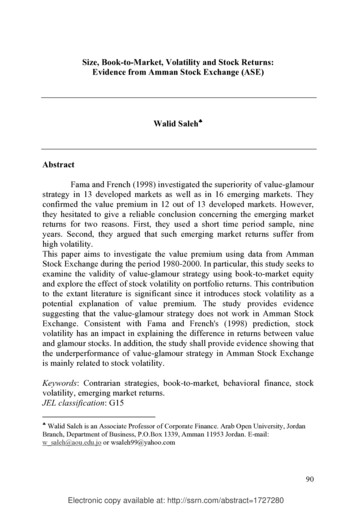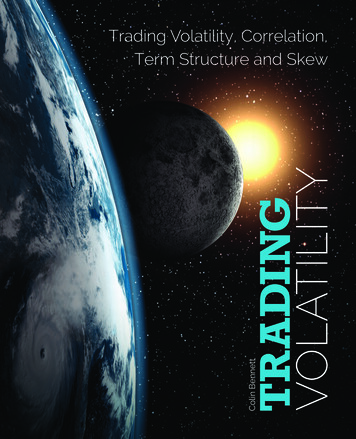
Transcription
Colin BennettTRADINGVOLATILITYTrading Volatility, Correlation,Term Structure and Skew
“A master piece to learn in a nutshellall the essentials about volatility witha practical and lively approach.A must read!”Carole Bernard, Equity DerivativesSpecialist at Bloomberg“This book could be seen as the‘volatility bible’!”Markus-Alexander Flesch, Head ofSales & Marketing at Eurex“I highly recommend this book bothfor those new to the equity derivativesbusiness, and for more advancedreaders. The balance between theoryand practice is struck At-The-Money”Paul Stephens, Head of InstitutionalMarketing at CBOE“One of the best resources out therefor the volatility community”Paul Britton, CEO and Founder ofCapstone Investment Advisors“Colin has managed to conveyoften complex derivative andvolatility concepts with an admirablesimplicity, a welcome change fromthe all-too-dense tomes one usuallyfinds on the subject”Edmund Shing PhD, former ProprietaryTrader at BNP ParibasABOUTTHEAUTHORColin Bennett is a Managing Director andHead of Quantitative and Derivative Strategyat Banco Santander. Previously he was Headof Delta 1 Research at Barclays Capital, andHead of Convertible and Derivative Researchat Dresdner Kleinwort.Colin started his career in Convertible BondResearch at Merrill Lynch, after studyingMathematics and Electrical Engineering atCambridge University. In the 1993 NationalMathematics Contest Colin came 16th in theUK. He has also worked in Equity DerivativeSales, and as a Desk Analyst for the equityderivative trading desk.Colin is a regular speaker at CBOE, Eurex,Marcus Evans, Futures and Option World, RiskMagazine and Bloomberg conferences.www.trading-volatility.com“In a crowded space, Colin hassupplied a useful and concise guide”Gary Delany, Director Europe at theOptions Industry CouncilAny questions regarding the content of this book can be emailed to author@colin-bennett.com.
TRADING VOLATILITYTrading Volatility, Correlation,Term Structure and SkewColin Bennett
Copyright 2014 Colin BennettAll rights reserved. No part of this publication may be reproduced, stored in a retrievalsystem, or transmitted in any form or by any means – electronic, mechanical, photocopying,recording or otherwise without written permission of the publisher or author.Trading Volatility: Trading Volatility, Correlation, Term Structure and SkewISBN-13: 978-1499206074Cover Design by Gareth Allen
ACKNOWLEDGEMENTSI would like to thank James Peattie for persuading me to work at Merrill Lynch, and startingmy career within research which I still enjoy to this very day.Iain Clamp aka “The Guru” deserves special recognition, for explaining the intricacies ofvolatility trading.I will always be grateful to Tom Dauterman and Irene Ferrero for their many months ofeffort proofing this publication. I would also like to thank Mariano Colmenar, withoutwhose support this book would never have been published.And finally, and most importantly, I would like to thank my wife Claire for her endlesspatience and understanding with me while I researched and wrote this book over the past 5years.
NOTE ON CONTENTSWhile there are many different aspects to volatility trading, not all of them are suitable for allinvestors. In order to allow easy navigation, the sections are combined into seven chaptersthat are likely to appeal to different parts of the equity derivatives client base. The earlierchapters are most suited to equity investors, while later chapters are aimed at hedge fundsand proprietary trading desks. The Appendix contains reference material and mathematicaldetail that has been removed from earlier chapters to enhance readability.
CONTENTSPREFACE . iCHAPTER 1OPTIONS. 11.1: Option basics . 21.2: Option trading in practice . 41.3: Maintenance of option positions . 111.4: Call overwriting . 151.5: Protection strategies using options . 231.6: Option structures trading . 31CHAPTER 2VOLATILITY TRADING . 352.1: Volatility trading using options . 362.2: Variance is the key, not volatility . 492.3: Volatility, variance and gamma swaps . 522.4: Options on variance . 68CHAPTER 3WHY EVERYTHING YOU THINK YOU KNOW ABOUT VOLATILITYIS WRONG . 733.1: Implied volatility should be above realized volatility . 743.2: Long volatility is a poor hedge . 773.3: Variable annuity hedging lifts long-term vol . 813.4: Structured products vicious circle. 833.5: Stretching black-scholes assumptions . 89CHAPTER 4FORWARD STARTING PRODUCTS AND VOLATILITY INDICES . 994.1: Forward starting products . 1004.2: Volatility indices. 1094.3: Futures on volatility indices . 1154.4: Volatility future ETN/ETF . 1224.5: Options on volatility futures . 129
CHAPTER 5LIGHT EXOTICS. 1335.1: Barrier options . 1345.2: Worst-of/best-of options. 1405.3: Outperformance options . 1435.4: Look-back options . 1465.5: Contingent premium options . 1485.6: Composite and quanto options . 149CHAPTER 6RELATIVE VALUE AND CORRELATION TRADING . 1536.1: Relative value trading . 1546.2: Relative value volatility trading . 1586.3: Correlation trading . 1616.4: Trading earnings announcements/jumps . 178CHAPTER 7SKEW AND TERM STRUCTURE TRADING. 1837.1: Skew and term structure are linked . 1847.2: Square root of time rule can compare term structures and skews. 1937.3: Term structure trading . 1987.4: How to measure skew and smile. 2017.5: Skew trading . 210APPENDIXA.1: Local volatility . 230A.2: Measuring historical volatility . 232A.3: Proof implied jump formula . 245A.4: Proof var swaps can be hedged by log contract ( 1/k2) . 248A.5: Proof variance swap notional vega/2. 250A.6: Modelling volatility surfaces. 251A.7: Black-scholes formula . 255A.8: Greeks and their meaning . 257A.9: Advanced (practical or shadow) greeks . 262A.10: Shorting stock by borrowing shares . 266A.11: Sortino ratio. 269A.12: Capital structure arbitrage . 270σINDEX . 286
PREFACEOne of the main reasons I decided to write this book, was due to the lack of otherpublications that deal with the practical issues of using derivatives. This publication aims tofill the void between books providing an introduction to derivatives, and advanced bookswhose target audience are members of quantitative modelling community.In order to appeal to the widest audience, this publication tries to assume the least amountof prior knowledge. The content quickly moves onto more advanced subjects in order toconcentrate on more practical and advanced topics.
CHAPTER 1OPTIONSThis chapter is focused on real life uses of options for directional investors, for exampleusing options to replace a long position in the underlying, to enhance the yield of aposition through call overwriting, or to provide protection from declines. In addition toexplaining these strategies, a methodology to choose an appropriate strike and expiryis shown. Answers to the most common questions are given, such as when an investorshould convert an option before maturity, and the difference between delta and theprobability that an option expires in the money.
2CHAPTER 1: OPTIONS1.1: OPTION BASICSThis section introduces options and the history of options trading. The definition ofcall and put options, and how they can be used to gain long or short equity exposure,is explained. Key definitions and terminology are given, including strike, expiry,intrinsic value, time value, ATM, OTM and ITM.HISTORY OF VOLATILITY TRADINGWhile standardised exchange traded options only started trading in 1973 when the CBOE(Chicago Board Options Exchange) opened, options were first traded in London from 1690.Pricing was made easier by the Black-Scholes-Merton formula (usually shortened to BlackScholes), which was invented in 1970 by Fischer Black, Myron Scholes and Robert Merton.Option trading exploded in the 1990sThe derivatives explosion in the 1990s was partly due to the increasing popularity of hedgefunds, which led to volatility becoming an asset class in its own right. New volatilityproducts such as volatility swaps and variance swaps were created, and a decade later futureson volatility indices gave investors listed instruments to trade volatility. In this chapter weshall concentrate on option trading.CALL OPTIONS GIVE RIGHT TO BUY, PUTS RIGHT TO SELLA European call is a contract that gives the investor the right (but not the obligation) to buya security at a certain strike price on a certain expiry date (American options can be exercisedbefore expiry). A put is identical except it is the right to sell the security.Call option gives long exposure, put options give short exposureA call option profits when markets rise (as exercising the call means the investor can buy theunderlying security cheaper than it is trading, and then sell it at a profit). A put option profitswhen markets fall (as you can buy the underlying security for less, exercise the put and sellthe security for a profit). Options therefore allow investors to put on long (profit whenprices rise) or short (profit when prices fall) strategies.
1.1: Option Basics3SELLING OPTIONS GIVES OPPOSITE EXPOSUREAs a call option gives long exposure to the underlying s
options trading gives volatility exposure If the volatility of an underlying is zero, then the price will not move and an option’s payout . is equal to the intrinsic value.
